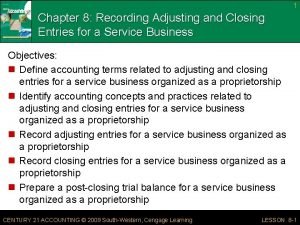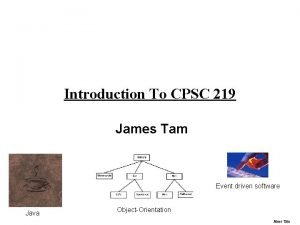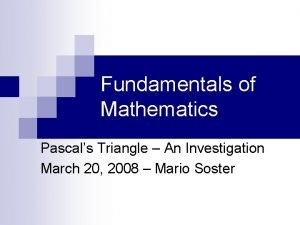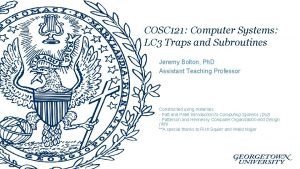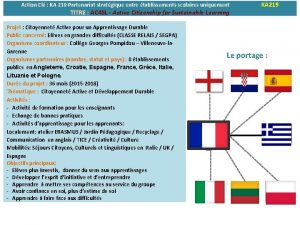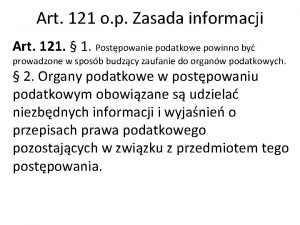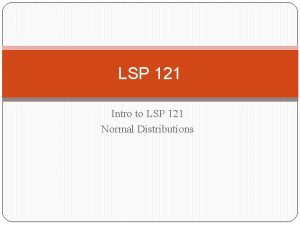Lesha u Jenki n ns JPLA 121 219





















- Slides: 21

Lesha u Jenki n ns JPLA 12//1 2/19 Closi ng Achi evem Gaps ent : Amon gst A Amer ican M fricanales I n Intr to Ma o th 1

The context of my Problem of Practice (Po. P) revolves around identifying the causes of achievement gaps that have existed amongst minority males, particularly in the area of Intro to Math (Math I) at Tarboro High School. Historically across the board, minority males have performed significantly lower than other subgroups, not only in Math , but also in other core subjects. 2

: m e l b o r P The Deep Data Dive Reveals Achievement Gaps • Classroom Observations were very telling that there was a problem. • One on One student Interviews revealed problems that existed within the pedagogical structuring of the class. • Benchmark data was very revealing of prior assumptions made about the problems of practice. 3

LOGIC MODEL 4

a t a D t a A Look Based on Benchmark Data, there is a 5%-21% achievement gap amongst African. American males and other subgroups. Subgroups Benchmark Data African American Males 23. 8% African American Females 34. 2% White Males 44. 5% White Females 29% Hispanic Males ----- Hispanic Females ------5

Data s n o s i r Compa African-American Males Benchmark Data 23. 85% All Other Subgroups Benchmark Data 35. 91% 6

Data s n o s i r a Comp African American Males 23. 85% White Males 44. 5% 7

Data s n o s i r Compa African-American Males 23. 85% African-American Females 34. 25% 8

Data s n o s i r a Comp African-American Males 23. 85% White Females 29% 9

” e v i t a r r a N e h “T 10

l l e h c t i Bryan M Day in The Life Shadowing Classification: Freshman Intro to Math 1 Mock Score: 24% Intro to Math 1 Benchmark Score: 14% 11

s n o i t p m Assu I believe the interventions that I have proposed will have a direct implication on instruction, student engagement, and student choice and voice. Ultimately I believe interventions will impact student achievement, especially amongst minority males. 12

s n o i t p m u s s A e Mor I believe that the proposed intervention will work based on qualitative data collected during observation and student interviews; 1. Student in student interview spoke about not understanding why he will need it in the future. 2. One student spoke about being bored; would like to learn Math through a lens that he can relate to. 3. Students spoke of wanting to collaborate more in groups/learning teams. The only day that I observed students being asked to turn and talk, the energy and engagement level was amazingly higher than any other time. 13

s e c r u o Resources include Intro to Math 1 Teachers, Math I Teachers, MCL for Math; Instructional Leaders, EC Teachers and Students. The curriculum that will be used will be the Math 1 Curriculum in addition to Unpacking Documents, Cross Walk Documents, and NCDPI released items, and Test Spec documents. In Departmental PLCs, teachers will look directly at achievement gaps weekly during their Data PLC. In this data dive, teachers will be able to identify students (minority males) who are lagging significantly behind other students. Teachers will design/prescribe proper interventions based on the data. 14

/ s e i t i v i Act s n o i t n e Interv 1. Weekly Data PLCs; evaluation of holistic data as well as individual student data to identify the multitude of the achievement gap, if one exist. Being intentional is key. 2. Weekly Planning PLCs: Planning should be done around the data outcomes; 3. PD centered around student achievement 4. Increase in student agency, voice, and choice 5. Focus of collaboration and collaborative learning opportunities ADD A FOOTER 15

e s e h T Why ? s n o i t n e v r e t n I • I selected these interventions because achievement gaps sometimes exists because of inequitable practices. With a focus on data driven instruction, with the intentionality lesson planning , I do believe that not only will gaps be identified, but I believe these achievement gaps will be marginalized as well. • The intentionally of the teacher & instructional leader, I feel strongly that there will be an increase in student performance, proficiency, and growth. 16

s t u p t u O d e r i Des • Effective and intentional PLC schedules (Math Department). • Student Data Tracking forms/systems (holistic and individual data) • Tracking document/sheet that populates student results/achievement gaps. 17

Desired s e m o c t Ou • An increase in overall holistic student performance across the board. • An increase in individualized student performance. 18

t c a p m I d e r i s De The desired impact is to: 1. Improve the quality of delivered instruction 2. Be intentional about disaggregating data, that could and should reveal achievement gaps 3. Integrate culturally aligned relevant Math instruction 4. Integrate collaborative learning opportunities 5. Increase student engagement through increased student agency, student voice, and student choice. 6. To see a significant decrease in the overall achievement gaps that exist amongst black males in the area of Into to Math I. 19

n o i t a u l Eva s n o i t s e Qu Research Questions? How will I obtain data? The data will be obtained through school based, district, and state mandated testing. Pre & Post Measures? Classroom Formative Assessments Quantitative /Qualitative Methods to evaluate Your project Quantitative Data (Mock scores, Benchmark scores, CFA scores, Classroom assessments, and EOC/NCFE Data. 20

Than k Yo u! Lesha un T. Jenki ns
 Calendario lunar 219
Calendario lunar 219 Post-closing trial balance
Post-closing trial balance Spm 219 textbook notes
Spm 219 textbook notes Cpsc 219
Cpsc 219 Fra 49 cfr part 219
Fra 49 cfr part 219 Ap 219
Ap 219 Prime factorization chart 1-200
Prime factorization chart 1-200 Ik hef mijn ogen op naar de bergen psalm 121
Ik hef mijn ogen op naar de bergen psalm 121 Mantener affirmative tu command
Mantener affirmative tu command Tit n
Tit n C 2 =121
C 2 =121 Forjadores de la patria 121
Forjadores de la patria 121 Ed law 2d part 121
Ed law 2d part 121 In the valley i will lift my eyes
In the valley i will lift my eyes In4matx 121
In4matx 121 Section 121 doctrine covenants
Section 121 doctrine covenants Mind map polinomial
Mind map polinomial Pascals identity
Pascals identity English 121
English 121 Psalm 121 msg
Psalm 121 msg Eee 121
Eee 121 Trap vector table lc3
Trap vector table lc3

